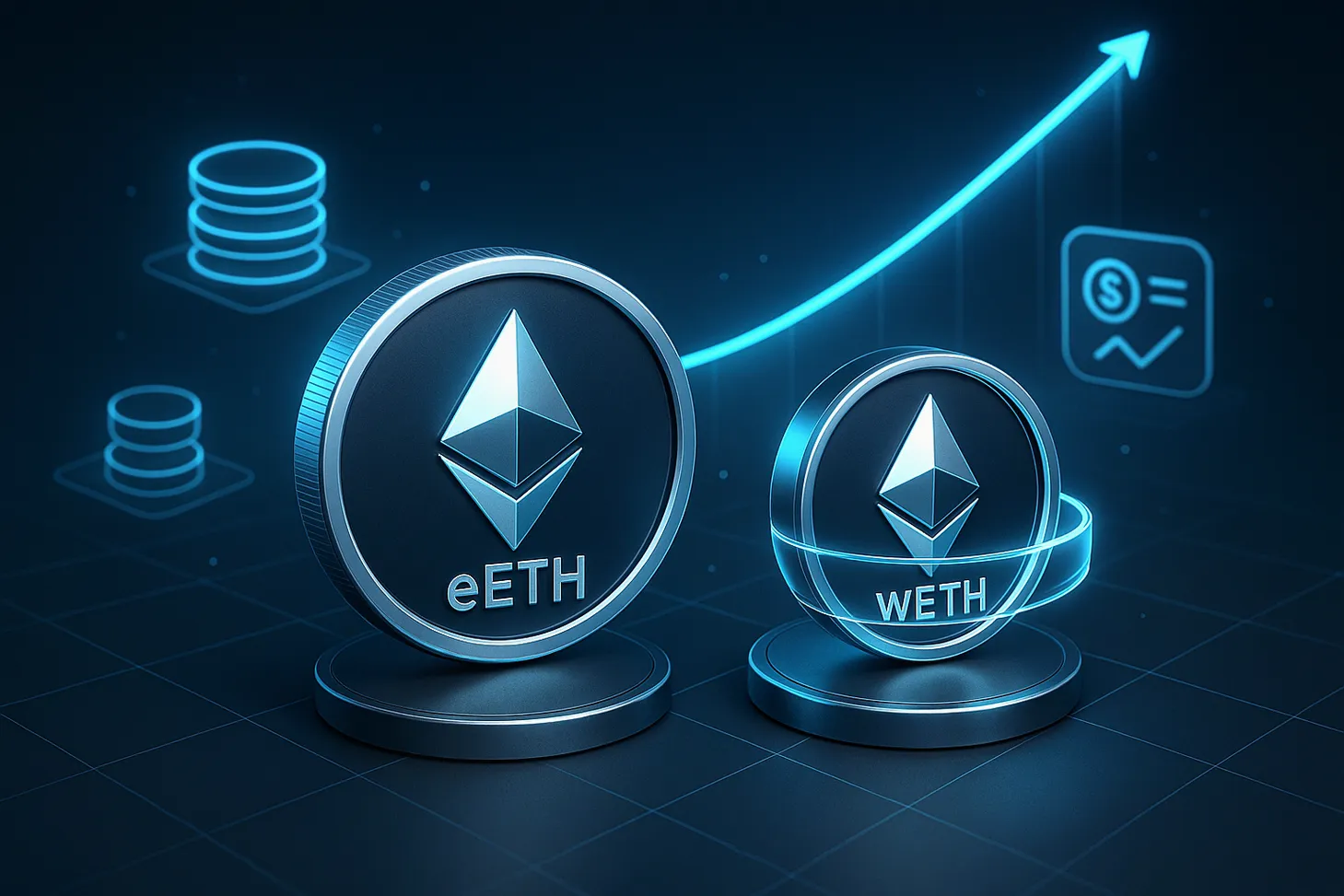If you’ve been watching Ethereum’s liquid staking and restaking ecosystem, you’ve likely seen eETH and its wrapped version, WEETH (often stylized as weETH). This guide unpacks exactly what WEETH is, how it works under the hood, why wrapping matters for DeFi, and how to use it responsibly across protocols.
Heads up: Nothing here is financial advice. Always do your own research and evaluate risks.
TL;DR for busy readers
- WEETH is the wrapped, non-rebasing version of Ether.fi’s eETH, designed for broad DeFi compatibility.
- eETH accrues staking and restaking rewards; wrapping turns those rebasing rewards into an increasing exchange rate for WEETH.
- WEETH can be used as collateral, in liquidity pools, and across DeFi apps that expect standard ERC‑20 tokens.
- You can acquire ETH and stablecoins cheaply on centralized exchanges like Bybit, then bridge and swap on-chain for WEETH. New users get a 20% fee discount and up to $30,050 in benefits with code CRYPTONEWER via this link: Join Bybit with code CRYPTONEWER.
What is Wrapped eETH(WEETH)
WEETH is the wrapped form of eETH, Ether.fi’s liquid restaking token (LRT). Ether.fi’s eETH represents staked ETH that is natively integrated with the EigenLayer restaking ecosystem. In simple terms:
- eETH = a token that tracks staked ETH plus rewards from Ethereum validators and potentially EigenLayer AVSs (Actively Validated Services).
- WEETH = a wrapped, non-rebasing ERC‑20 representation of eETH that’s more convenient for integrations.
Why wrapping matters:
– Many DeFi protocols prefer non-rebasing ERC‑20 tokens. Rebasing tokens adjust balances periodically, which can break accounting in lending, perps, or AMM pools.
– WEETH solves this by fixing your token balance while letting the exchange rate vs. eETH/ETH drift upward as rewards accumulate.
This structure closely mirrors other popular pairs like stETH vs. wstETH. If you’ve used those, WEETH will feel familiar.
How eETH and WEETH work together
- eETH is commonly a rebasing token, meaning your balance rises over time as staking/restaking rewards accrue.
- WEETH is non-rebasing. Instead of your token count increasing, the value of each WEETH rises relative to eETH/ETH via an exchange rate that updates over time.
A simple mental model:
– Wrap: You deposit eETH and receive WEETH at the current exchange rate.
– Unwrap: You return WEETH and receive eETH, again using the updated exchange rate.
That exchange rate tends to increase as rewards are earned, reflecting staking yields and, if applicable, EigenLayer restaking yields. There is no magic yield farming; it’s simply a different accounting model that makes life easier for DeFi.
The math of wrapping and unwrapping
Let’s define a variable:
– R = current eETH per WEETH exchange rate
- When you wrap: eETHdeposited / R = WEETHminted
- When you unwrap: WEETHreturned × R = eETHreceived
Because R generally creeps upward as rewards accrue, the same WEETH tends to unwrap into more eETH over time.
Note: There may be protocol-specific minimums, fees, or delays associated with mint/redeem vs. swap-on-DEX liquidity. Many users opt to swap WEETH on AMMs when that’s cheaper or faster than protocol redemptions.
Where WEETH fits in DeFi
- Collateral in lending markets: Non-rebasing design makes WEETH a cleaner collateral candidate for money markets that require stable balances. Support varies by protocol and network; always check current listings and LTV parameters.
- Liquidity pools: AMMs like Uniswap or Curve may host WEETH pairs (e.g., WEETH/ETH). Spreads and fees can be better than mint/redeem depending on market conditions.
- Yield strategies: Protocols can integrate WEETH to build structured yield products, tranching, or interest-rate strategies. Keep in mind smart contract and integration risk.
- Derivatives and hedging: Non-rebasing ERC‑20 tokens are easier to plug into perps, options, and basis trades.
Search long-tail queries you might care about:
– “How to wrap eETH to WEETH”
– “WEETH vs wETH difference”
– “Is WEETH safe for collateral”
– “Best liquidity pools for WEETH”
How to get WEETH step by step
1) Acquire ETH or stablecoins
– Use a centralized exchange to buy ETH or stablecoins with low fees and deep liquidity.
– New users can tap a strong promo on Bybit: 20% spot fee discount and up to $30,050 in benefits. Sign up here with the referral code embedded in the link: Join Bybit with code CRYPTONEWER.
2) Bridge to Ethereum mainnet (if needed)
– If you purchased assets on another chain or L2, bridge to the network where WEETH has the best liquidity (commonly Ethereum mainnet). Use reputable bridges and be mindful of fees.
3) Convert to WEETH
– Option A: Swap on a DEX that lists WEETH (e.g., a WEETH/ETH pool). This is often the fastest route but check price impact and slippage.
– Option B: Mint/wrap via the Ether.fi interface if supported in your region and wallet. This may involve first obtaining eETH and then wrapping to WEETH.
4) Put WEETH to work
– Provide liquidity in select pools, use as collateral where listed, or deploy into a strategy vault. Always check APYs, lockups, and smart contract risk.
Pro tip: Keep gas in ETH, and consider batching transactions to minimize fees during peak network usage.
WEETH vs. wETH vs. other LSTs/LRTs
-
WEETH vs wETH
- wETH wraps native ETH to a standard ERC‑20. It does not earn staking yield by itself.
- WEETH wraps eETH, which tracks staked/restaked ETH. It is yield-bearing via an increasing exchange rate.
-
WEETH vs stETH/wstETH
- Similar concept to wstETH: non-rebasing wrapper optimized for DeFi.
- Differences lie in validator sets, operators, reward sources, and risk profiles between Ether.fi and other LST issuers.
-
WEETH vs rETH
- rETH is Rocket Pool’s non-rebasing LST. It’s not the same as a wrapped, rebasing token but conceptually comparable in that value rises via exchange rate.
- WEETH specifically represents wrapped eETH from Ether.fi, which is natively integrated with EigenLayer restaking.
Fees, yields, and the exchange rate
- Yield sources may include Ethereum staking rewards, execution-layer tips, MEV, and—when active—EigenLayer AVS rewards. The composition is variable and evolves over time.
- Fee structure is set by the protocol (Ether.fi and any integrated services). Review current fee schedules before committing capital.
- Exchange rate growth is not guaranteed. Earnings depend on validator performance, AVS distributions, and market conditions. Rates fluctuate.
Always compare:
– Net APY after fees
– On-chain gas and slippage
– Opportunity cost vs. alternative LSTs/LRTs
Key risks you should understand
- Smart contract risk: Wrappers, AMMs, money markets, and strategy vaults add layers of contracts. More layers can mean more attack surface.
- Custodial and operator risk: Validator performance and slashing controls matter. Restaking adds complexity with AVS-specific risk.
- Liquidity risk: WEETH liquidity varies by venue. Large orders can move price. In volatile markets, spreads can widen.
- Depeg and discount risk: Market prices for yield-bearing tokens can trade at premiums/discounts vs. theoretical value. Watch for persistent discounts, particularly during stress.
- Bridge and cross-chain risk: Bridged WEETH representations depend on bridge security and liquidity on the destination chain.
- Regulatory and tax risk: Jurisdictional rules change. Treat yield-bearing assets with care from an accounting standpoint.
Mitigation pointers:
– Prefer audited, battle-tested protocols; size positions accordingly.
– Use limit orders and set slippage controls on DEXs.
– Diversify across assets and venues rather than concentrating in a single LRT.
Security and audits
- Check Ether.fi documentation for audit references and the latest security disclosures.
- Review DeFi integrations individually; a safe base token can still be exposed to downstream protocol risk.
- Consider multisig, timelocks, and bug bounty programs as part of your due diligence.
Common FAQs about What is Wrapped eETH(WEETH)
-
Is WEETH an ERC‑20 token?
- Yes. The wrapped design makes WEETH a standard ERC‑20, which eases integration with DeFi apps.
-
Can I convert WEETH back to eETH and then to ETH?
- Typically yes, via unwrapping and then redeeming eETH for ETH (directly or by swapping on a DEX). Exact flows depend on current protocol routes and liquidity.
-
Why is WEETH better for DeFi than eETH in some cases?
- Because WEETH doesn’t rebase, balances stay constant while value accrues via exchange rate. Many protocols expect fixed balances.
-
Does WEETH guarantee a higher APY than other LSTs/LRTs?
- No. APY is variable and depends on validator performance, fees, and restaking distributions. Compare net yields across assets.
-
Where does WEETH exist?
- Primarily on Ethereum mainnet. Bridged versions may exist; always verify contract addresses and bridge integrity.
-
How do I minimize costs when entering WEETH positions?
- Hunt for tight-spread pools, use limit orders on aggregators when supported, transact during lower gas periods, and compare DEX swap vs. mint/unwrap flows.
Practical workflow for a first WEETH position
1) Fund your account, buy ETH on a deep-liquidity CEX
– Consider Bybit for competitive fees and onboarding benefits. New users can claim a 20% fee discount and up to $30,050 in bonuses using referral code CRYPTONEWER: Start on Bybit with CRYPTONEWER.
2) Move on-chain and swap
– Bridge to Ethereum mainnet if needed. Use a reputable DEX or Ether.fi’s interface to obtain WEETH, watching slippage and gas.
3) Deploy capital thoughtfully
– For liquidity providers: analyze pool mechanics (concentrated vs. standard), fee tiers, and historical volume.
– For lenders/borrowers: understand LTV, liquidation thresholds, oracle sources, and interest-rate models.
– For structured products: vet smart contracts, audits, and track record.
4) Manage risk and monitor performance
– Set alerts for price deviations and discounts relative to theoretical value.
– Track the WEETH exchange rate, net APY, and pool health.
Why traders and builders choose WEETH
- Integration-friendly: Non-rebasing ERC‑20 simplifies accounting and collateralization.
- Composable yield: One token can plug into many strategies while accruing staking/restaking rewards via the exchange-rate mechanism.
- Ecosystem momentum: Ether.fi and EigenLayer have spurred rapid innovation in restaking infrastructure and AVS design, potentially expanding WEETH utility over time.
Exclusive promo for readers
If you’re preparing to on-ramp or rebalance before moving into WEETH positions, consider Bybit’s current offer:
- 20% fee discount
- Up to $30,050 in benefits for new users
- Use referral code CRYPTONEWER via this link: Claim your Bybit benefits with CRYPTONEWER
Lower trading costs can materially improve net returns when you’re bridging, swapping, and rebalancing into yield-bearing assets like WEETH.
Quick glossary
- LST (Liquid Staking Token): A tokenized claim on staked ETH plus rewards.
- LRT (Liquid Restaking Token): A tokenized claim on staked ETH that’s also restaked into EigenLayer AVSs.
- Rebasing token: Balance changes over time as rewards accrue (e.g., eETH in many designs).
- Non-rebasing wrapper: Balance stays constant; value accrues via exchange rate (e.g., WEETH).
- AVS: Actively Validated Service; external services that leverage Ethereum validator security via EigenLayer.
Additional resources
- Ether.fi documentation and app (verify official URLs before connecting wallets)
- EigenLayer docs for AVS mechanics and slashing conditions
- DEX aggregators for best-route WEETH swaps
- On-chain analytics tools to monitor WEETH liquidity, discounts, and yields
Not financial advice. Crypto assets carry risk, including potential loss of principal. Always verify contract addresses and protocol security, and size positions based on your own risk tolerance.





